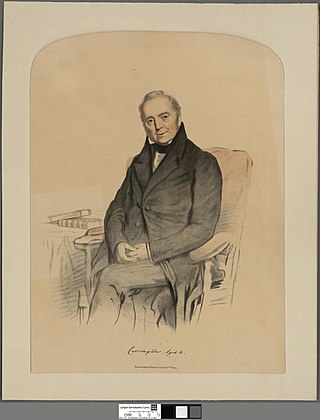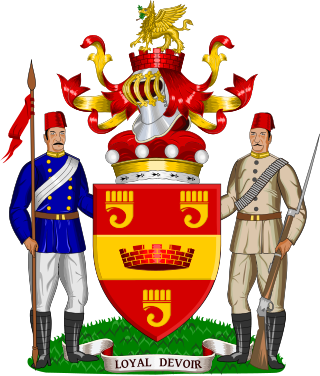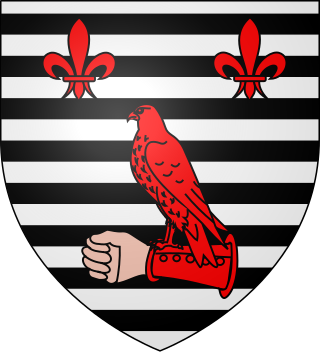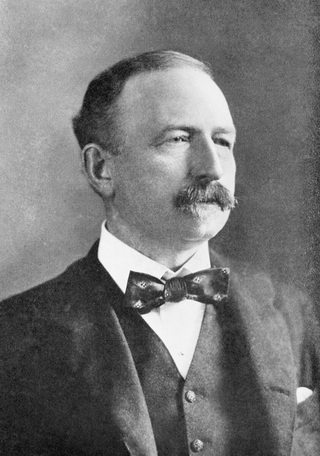Arms
  |
|
Baron Luke, of Pavenham in the County of Bedford, is a title in the Peerage of the United Kingdom. It was created in 1929 for the businessman George Lawson Johnston. [1] He was the second son of John Lawson Johnston, the founder of Bovril Ltd. As of 2015 [update] the title is held by his great-grandson, the fourth Baron, who succeeded his father in 2015. The third baron was one of the ninety elected hereditary peers to remain in the House of Lords after the passing of the House of Lords Act 1999. He sat on the Conservative benches until resigning from the House in 2015.
The heir apparent is the present holder's son Samuel Arthur St. John Lawson Johnston (b. 2000).
  |
|

Viscount Hailsham, of Hailsham in the County of Sussex, is a title in the Peerage of the United Kingdom. It was created in 1929 for the lawyer and Conservative politician Douglas Hogg, 1st Baron Hailsham, who twice served as Lord High Chancellor of the Great Britain. He had already been created Baron Hailsham, of Hailsham in the County of Sussex, in 1928, also in the Peerage of the United Kingdom. Hogg was the son of the merchant and philanthropist Quintin Hogg, seventh son of Sir James Hogg, 1st Baronet, whose eldest son James McGarel-Hogg, 2nd Baronet was created Baron Magheramorne in the Peerage of the United Kingdom in 1887.

Marquess Camden is a title in the Peerage of the United Kingdom. It was created in 1812 for the politician John Pratt, 2nd Earl Camden. The Pratt family descends from Sir John Pratt, Lord Chief Justice from 1718 to 1725. His third son from his second marriage, Sir Charles Pratt, was also a prominent lawyer and politician and served as Lord Chancellor between 1766 and 1770. In 1765 he was raised to the Peerage of Great Britain as Baron Camden, of Camden Place in the County of Kent, and in 1786 he was further honoured when he was created Viscount Bayham, of Bayham Abbey in the County of Kent, and Earl Camden. These titles are also in the Peerage of Great Britain. Lord Camden was married to Elizabeth, daughter of Nicholas Jeffreys, of The Priory, Brecknockshire, in Wales.

Viscount Astor, of Hever Castle in the County of Kent, is a title in the Peerage of the United Kingdom. It was created in 1917 for the financier and statesman William Waldorf Astor, 1st Baron Astor. He had already been created Baron Astor, of Hever Castle in the County of Kent, in 1916, also in the Peerage of the United Kingdom.

Baron Carrington is a title that has been created three times, once in the Peerage of England, once in the Peerage of Ireland and once in the Peerage of Great Britain.

Baron Grenfell, of Kilvey in the County of Glamorgan, is a title in the Peerage of the United Kingdom. It was created on 15 July 1902 for the military commander Sir Francis Grenfell. His eldest son, the second Baron, was Deputy Speaker of the House of Lords and Chairman of Committees from 1963 to 1976. As of 2010 the title is held by the latter's son, the third Baron, who succeeded in 1976. He previously worked for the World Bank. Lord Grenfell lost his seat in the House of Lords after the passing of the House of Lords Act 1999. However, in 2000 he was made a life peer as Baron Grenfell of Kilvey, of Kilvey in the County of Swansea, and was able to return to the House of Lords.

Baron Glenarthur, of Carlung in the County of Ayr, is a title in the Peerage of the United Kingdom. It was created in 1918 for the Scottish businessman Sir Matthew Arthur, 1st Baronet. He had already been created a baronet, of Carlung in the County of Ayr, on 28 November 1902. The title of the barony was derived from the joining of his mother's maiden surname name of Glen and his patronymic Arthur.

Baron Annaly is a title that has been created three times, twice in the Peerage of Ireland and once in the Peerage of the United Kingdom. Annaly is named after the ancient term for the general locale, which in turn was named after the original ancient king. The third creation is currently extant.
Baron Addington, of Addington in the County of Buckingham, is a title in the Peerage of the United Kingdom. It was created on 22 July 1887 for the businessman and Conservative Member of Parliament, John Hubbard. He was head of the firm of John Hubbard & Co and also sat as a Member of Parliament for Buckingham and the City of London. His eldest son, the second Baron, was a partner in the family firm and represented Buckingham in the House of Commons as a Conservative. He was succeeded by his eldest son, the third Baron. He was three times Mayor of Buckingham. On the death of his younger brother, the fourth Baron, the line of the eldest son of the first Baron failed. The title passed to their first cousin once removed, the fifth Baron. He was the grandson of Cecil John Hubbard, third son of the first Baron. As of 2018, the title is held by his eldest son, the sixth Baron. He is one of the ninety elected hereditary peers that remain in the House of Lords after the passing of the House of Lords Act of 1999. Lord Addington sits on the Liberal Democrat benches.

Baron Astor of Hever, of Hever Castle in the County of Kent, is a title in the Peerage of the United Kingdom. It was created in 1956 for John Jacob Astor, a prominent newspaper proprietor and Conservative politician. He was the fourth child of William Waldorf Astor, 1st Viscount Astor. Lord Astor of Hever was succeeded in 1971 by his eldest son, the second Baron, who served as Lord Lieutenant of Kent between 1972 and 1982.

Baron Shaughnessy, of the City of Montreal in the Dominion of Canada and of Ashford in the County of Limerick, is a title in the Peerage of the United Kingdom. It was created in 1916 for the Milwaukee born businessman Thomas Shaughnessy, president of the Canadian Pacific Railway Company. He was succeeded by his eldest son, the second Baron, a Director of the CPR and of the Canadian Bank of Commerce. His son, the third Baron, was a businessman and was also active in the House of Lords. However, he lost his hereditary seat in parliament after the House of Lords Act 1999.

Baron Ponsonby of Shulbrede, of Shulbrede in the County of Sussex, is a title in the Peerage of the United Kingdom. It was created in 1930 for the politician Arthur Ponsonby. Ponsonby was the third son of General Sir Henry Ponsonby and the great-grandson of Frederick Ponsonby, 3rd Earl of Bessborough. Frederick Ponsonby, 1st Baron Sysonby, was his elder brother. The first Baron's grandson, the third Baron, was also a Labour politician and notably served as Opposition Chief Whip in the House of Lords in the 1980s. As of 2017 the title is held by the latter's only son, the fourth Baron, who succeeded in 1990. He sat on the Labour benches in the House of Lords prior to the passing of the House of Lords Act 1999, when he lost his seat. However, in 2000 he was given a life peerage as Baron Ponsonby of Roehampton, of Shulbrede in the County of West Sussex, and was able to retake his seat in the House of Lords.
Baron Mancroft, of Mancroft in the City of Norwich, is a title in the Peerage of the United Kingdom. It was created in 1937 for the Conservative politician Sir Arthur Samuel, 1st Baronet. He had already been created a Baronet, of Mancroft in the City of Norwich in the County of Norfolk, in 1932. His son, the second Baron, was also a Conservative politician. In 1925 he assumed by deed poll the surname of Mancroft. As of 2010 the titles are held by the latter's only son, the third Baron, who succeeded in 1987. He is one of the ninety elected hereditary peers that remain in the House of Lords after the passing of the House of Lords Act of 1999. Lord Mancroft sits on the Conservative benches.
Baron Basing, of Basing Byflete and of Hoddington, both in the County of Southampton, is a title in the Peerage of the United Kingdom. It was created in 1887 for the Conservative politician and former President of the Local Government Board, George Sclater-Booth. On his death the title passed to his eldest son, the second Baron, and then to his son, the third Baron. On the latter's death in 1983 this line of the family failed. The title was inherited by the late Baron's first cousin, the fourth Baron. He was the son of Charles Lutle Sclater-Booth, second son of the first Baron. As of 2010 the title is held by the fourth Baron's grandson, the sixth Baron, who succeeded his father in 2007.

Baron Burnham, of Hall Barn in the Parish of Beaconsfield in the County of Buckingham, is a title in the Peerage of the United Kingdom. It was created on 31 July 1903 for the influential newspaper magnate Sir Edward Levy-Lawson, 1st Baronet, owner of The Daily Telegraph. He had already been created a Baronet, of Hall Barn in The Parish of Beaconsfield in the County of Buckingham and of Peterborough Court in the City of London, in the Baronetage of the United Kingdom on 13 October 1892. Levy-Lawson was the son of Joseph Moses Levy, who acquired The Daily Telegraph only months after its founding.

Baron Trevethin, of Blaengawney in the County of Monmouth, is a title in the Peerage of the United Kingdom. It was created in 1921 for the prominent judge Sir Alfred Lawrence, Lord Chief Justice of England from 1921 to 1922.
Baron Crathorne, of Crathorne in the North Riding of the County of York, is a title in the Peerage of the United Kingdom. It was created in 1959 for the Conservative politician and former Minister of Agriculture and Fisheries, Sir Thomas Dugdale, 1st Baronet. He had already been created a baronet, of Crathorne in the North Riding of the County of York, in 1945. As of 2016 the titles are held by his son, the second Baron, who succeeded in 1977. Lord Crathorne is one of the ninety elected hereditary peers that remain in the House of Lords after the passing of the House of Lords Act 1999, and sits as a Conservative.
Baron Leighton of St Mellons, of St Mellons in the County of Monmouth, is a title in the Peerage of the United Kingdom. It was created on 25 January 1962 for the Welsh shipping magnate Sir Leighton Seager, 1st Baronet. He was the son of Sir William Henry Seager. Seager had already been created a Baronet, of St Mellons in the County of Monmouth on 1 July 1952. As of 2023 the titles are held by his great-grandson, the fourth Baron, who succeeded his father on 28 May 2023. (Ref.- peerage news - At the date of 16 October 2023 the new Baron had not proved his succession,but had requested to be listed on the Official Roll of the Peerage by the House of Lords,. From The House of Lords Minutes of 8 November 2023, the Lord Chancellor reported that Richard Leighton Seager had established his claim to the Barony of Leighton and Saint Mellons in the Peerage of the United Kingdom.

Arthur Charles St John Lawson Johnston, 3rd Baron Luke KStJ was a British peer. He was one of the ninety hereditary peers elected to remain in the House of Lords after the passing of the House of Lords Act 1999 until his retirement in 2015.

George Lawson Johnston, 1st Baron Luke, KBE, was a British businessman.

Earl of Arran is a title in the Peerage of Ireland. It is not to be confused with the title Earl of Arran in the Peerage of Scotland. The two titles refer to different places: the Aran Islands in Ireland, and the Isle of Arran in Scotland. The Irish earldom is held by the Gore family. The Scottish earldom is a separate title, held as a subsidiary title of the Duke of Hamilton.